Roskilde Cathedral: Roskilde was named the capital city of Denmark by King Harald 'Bluetooth' Gormsson around 960. The present Roskilde Cathedral was built in the 12th and 13th centuries on the site of an earlier wooden stave church built by King Harald Bluetooth, this Viking king converted Denmark to Christianity. The choir of Roskilde Cathedral was consecrated in 1225. It is said that King Harald Bluetooth was buried in one of the pillars of the choir. The altar piece was made in Antwerp in 1560, it was taken as payment for the Sound Toll. Roskilde Cathedral is situated close to Roskilde Fjord. Roskilde Cathedral was the first Gothic cathedral in Scandinavia to be built of brick, the cathedral has both Romanesque and Gothic architectural features in its design. Numerous churches in Northern Europe were modelled after the red-brick cathedral. Roskilde Cathedral has been the burial place for the Danish Royal Family since the 15th century, with only one exception, all Danish kings and queens have been buried in the cathedral. The tombs of the Danish Royal Family can be found throughout the cathedral and in the chapels. Many side chapels were built up to the end of the 19th century. The most imposing is the chapel of King Christian IV. Roskilde Cathedral and the monuments at Jelling are the most important national and historic sites in Denmark. Several other World Heritage Sites are located not far from Roskilde: Jægersborg Dyrehave about 43 km to the northeast; Stevns Klint about 48 km to the southeast; Kronborg Castle about 69 km to the northeast. Roskilde Cathedral gained the status as a UNESCO World Heritage in 1995.
www.werelderfgoedfotos.nl © Copyright World Heritage Photos
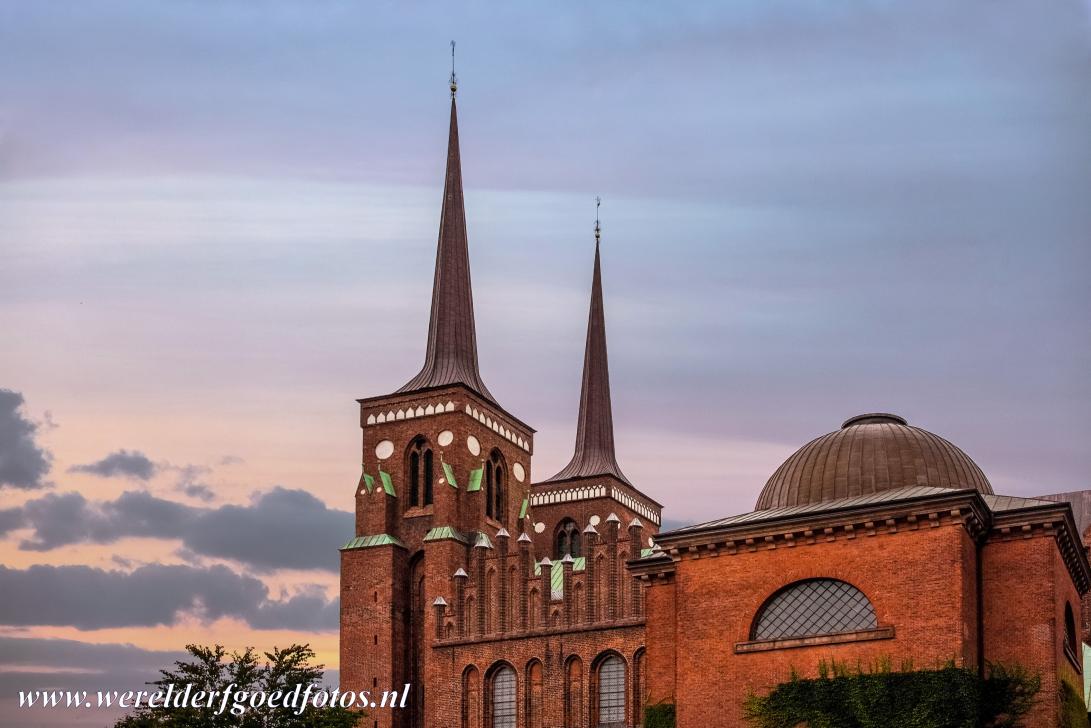
The twin towers of Roskilde Cathedral dominate the skyline of Roskilde City. Roskilde Cathedral was built in the 12th and 13th centuries on the location of an earlier wooden church, many side chapels were built up to the end of the 19th century. It was the first cathedral in Scandinavia to be built of brick. Roskilde Cathedral is located nearby the Roskilde Fjord. Roskilde Cathedral was declared a UNESCO World Heritage in 1995.

The twin towers of Roskilde Cathedral dominate the skyline of Roskilde City. Roskilde Cathedral was built in the 12th and 13th centuries on the location of an earlier wooden church, many side chapels were built up to the end of the 19th century. It was the first cathedral in Scandinavia to be built of brick. Roskilde Cathedral is located nearby the Roskilde Fjord. Roskilde Cathedral was declared a UNESCO World Heritage in 1995.
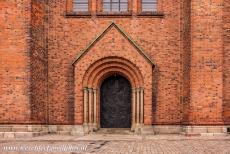
Roskilde Cathedral: The King's Door is situated in the west façade of the cathedral. The outside of the bronze door represents the twelve apostles of Jesus and their symbols. In 2010, the door replaced an oak door from 1872. The door is used only for leaving the cathedral after weddings, conformations and funerals, the King's Door is also used as an entrance for royal visits. Roskilde Cathedral encouraged the spread of the brick Gothic style throughout northern Europe.
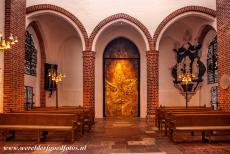
Inside Roskilde Cathedral the eye catches the golden reflection of the King's Door, the reflection interacts with the golden altarpiece opposite the bronze door, this golden appearance has been achieved by using polished bronze that has been patinated. The inside of the King's Door is 1.5 metres higher than the outside, therefore a semicircular tympanum was placed above the door, adorned with a wheat field, the many ears of wheat refer to the bread broken by Jesus Christ.
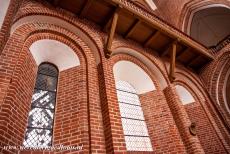
Roskilde Cathedral: The Romanesque windows of the cathedral. Roskilde was named the capital city of Denmark by the Danish King Harald 'Bluetooth' Gormsson around 960 AD, he converted his country Denmark to Christianity. The present-day Roskilde Cathedral was built in the 12th and 13th centuries on the site of an earlier wooden stave church built by King Harald Bluetooth. The cathedral is the burial place of the Danish Royal Family.
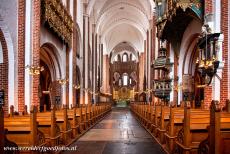
The pulpit of Roskilde Cathedral was a gift of King Christian IV in 1610. The construction of the present cathedral started around 1170, the choir was completed in 1225 and consecrated in the same year. The Gothic cathedral was completed in 1280, but it had only one tower, the second tower was completed around 1400. In the 16th century, Renaissance elements were added. The present spires of Roskilde Cathedral were built around 1635.
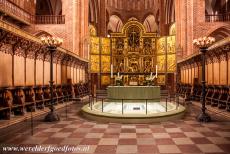
Roskilde Cathedral: The gilded altarpiece was created in Antwerp around 1560, the altarpiece is adorned with gilded square plates, depicting the life, death and ressurection of Jesus Christ, the altar piece was originally intended for a church in Danzig, but was requisitioned by the Danish customs authorities at Kronborg Castle as payment for the Sound Toll. Several royal tombs are situated behind the gilded altarpiece.
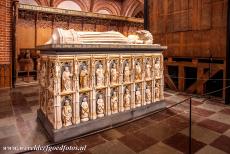
The elaborately decorated tomb of Queen Margrethe I of Denmark is situated behind the High Altar in Roskilde Cathedral. The tomb was made by the sculptor Johannes Junge in 1423. Queen Margrethe I (1353-1412) was one of the greatest monarchs of Scandinavia, she unified Sweden, Norway and Denmark by the Union of Kalmar in 1397. The Union of Kalmar lasted until Sweden became independent in 1523. Roskilde Cathedral became a UNESCO World Heritage in 1995.
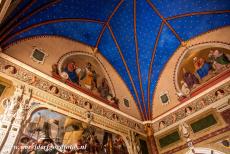
Roskilde Cathedral: King Christian IV ordered to build a chapel in the cathedral after the death of his wife Queen Anne Catherine in 1612. The work on the Christian IV Chapel started in 1614. The exterior of the chapel was built in red bricks with a crow-stepped gable and was completed in 1641. Upon the death of Christian IV in 1648, the interior of the chapel was not yet finished. The chapel was completed in 1870, more than two centuries later.
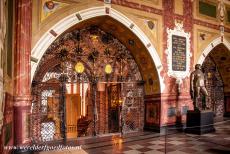
Roskilde Cathedral: The Christian IV Chapel. Inside Roskilde Cathedral, the Christian IV Chapel is separated from the nave by a wrought-iron lattice, the lattice was made in 1619. The outside of the Christian IV Chapel was built in the Dutch Renaissance style. Nowadays, there are five tombs in the chapel, among them the tombs of King Christian IV and his wife Queen Anne Catherine of Brandenburg, King Frederik III and his wife Sophie Amalia of Brunswick-Lüneburg.
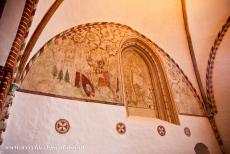
Roskilde Cathedral: A fresco painted in 1511 on the wall of the Chapel of St. Andrew, it depict the Virgin Mary holding the Infant Jesus in her arms and on the left hand side a depiction of the beheading of John the Baptist. In later centuries, the frescoes were covered with a layer of thick white wash, they were rediscovered following restoration works. The Chapel of St. Andrew was built in 1395. Roskilde Cathedralone is of the most important national monuments of Denmark.
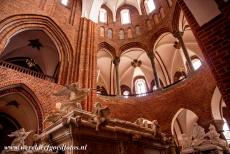
Roskilde Cathedral is a Gothic cathedral, but it has both Gothic and Romanesque architectural features in its design. The chancel of Roskilde Cathedral was consecrated in 1225. It is said that King Harald Bluetooth was buried in one of the pillars of the choir. The King's Pillar in the centre of the Chapel of King Christian I carries a row of markings indicating the height of royal visitors, such as Tsar Peter the Great of Russia (208.4 cm) and the Danish King Christian IV.
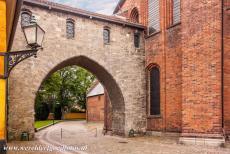
Roskilde Cathedral: The Arch of Absalon built in the 13th century. Stones of an earlier travertine church were used to built the Gothic arch. The Arch of Absalon connects Roskilde Cathedral with the Bishop's Mansion. The roofed passageway is only accessible to the Danish clergy. The Arch of Absalon was named after Bishop Absalon of Roskilde (1128-1201), he was also an important politician and the closest advisor of King Valdemar I of Denmark.
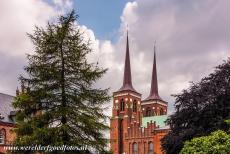
The square twin towers of Roskilde Cathedral. The cathedral has been the main burial place for the members of the Danish Royal Family since the 15th century. With only one exception, all the Danish kings and queens have been buried in the cathedral. The tombs of the Royal Family can be found throughout the cathedral and also in the numerous side chapels. Roskilde Cathedral was inscribed on the UNESCO World Heritage List in 1995.
